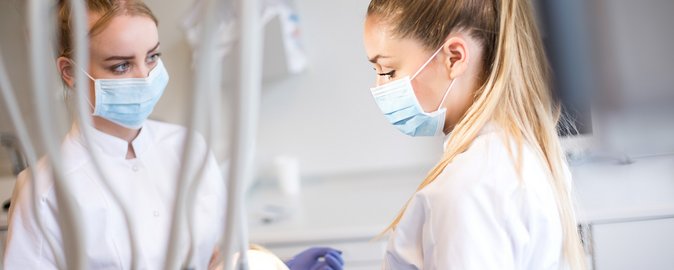- Education
-
Research
Current research
Talent
-
Collaboration
Businesses
Government agencies and institutions
Alumni
-
About AU
Organisation
Job at AU
While the development of the new dental study programmes quietly continues at Health, what is known as ‘The Aarhus Model of Dental Education’ has earned plenty of attention internationally. Combining educations and teaching might seem obvious. Nonetheless, no one has really done it before.
2021.02.25 |

From August 2022, The Aarhus Model of Dental Education will be implemented at Department of Dentistry and Oral Health. Photo: Lars Kruse
Dentist, dental hygienist, clinical dental technician, dental surgery assistant and dental technician. Five study programmes in the orofacial area that until a few years ago hardly had more in common than white lab coats and the same address in the University Park. Today, the Department of Dentistry and Oral Health is well on the way to breaking down the otherwise robust educational silos by revising and combining all of the study programmes, and by building an educational model not seen anywhere else in the world.
"We wanted to create synergy. And because we’re both academically and physically close to each other, we could clearly see the benefits of our graduates, regardless of the type of education, standing on the same academic foundation. From day one working in Denmark's dental clinics, they need to know about each other's competences and work closely together – so why not become familiar with team-based dental care already during their study programme," says Deputy Head of Department for Education Caroline Hørsted, who is heading the revision process.
Among other things, she explains how parts of the clinical training will in future be carried out jointly, so that the different students work together on the patients in the clinic, which is not currently the case.
How do you even begin such a fundamental task? Caroline Hørsted points to two crucial circumstances: The 2016 organisational merger of the Department of Dentistry and the School for Dental Assistants, Hygienists and Clinical Technicians, together with the faculty's vision process for the study programmes at Health in 2017.
"The merger and the vision process kick-started The Aarhus Model of Dental Education. Now we had the opportunity – and the resources – to think in new ways, do something completely different and convert the wishes we long had held into a new degree programme structure. We took that opportunity," says Caroline Hørsted, and continues: "And the fact that international educational institutions follow and acknowledge our work has given us an extra boost."
There is no doubt that international education institutions are keeping an eye on the project. Mike Curtis is one of those who have closely followed the process. He is Executive Dean and Professor of Microbiology at the Faculty of Dentistry, Oral & Craniofacial Sciences at King's College in London, as well as being a member of the faculty's Advisory Board.
"The Aarhus model is designed to overcome the educational silos and barriers that we see virtually everywhere around the world. It’s a really ambitious project, and I look forward to following the experiences they have – good and bad – because I believe that Aarhus can have an impact on how we shape the orofacial degree programmes in the future," says Mike Curtis.
The work began with clear qualification profiles for all the degree programmes that needed to work closer together. Next followed work to decide which subjects and courses should be included where and when, so that it would be logistic possible to have teaching across the programmes. This part of the process is still underway and has required changes to all of the academic regulations. According to Caroline Hørsted, this is where the vision puts a strain on things:
"This part requires an extreme amount of cross-disciplinary coordination, as we’re constantly trying to integrate our degree programmes, teaching, resources and clinical facilities. And if a degree programme element is important to everyone, it must take place at the same time in all degree programmes in order to ensure synergy. It’s a real jigsaw puzzle.”
Caroline Hørsted also says that the collaboration has been an eye-opener.
"It’s become clear that we can actually plan in a way that enables us to utilise facilities such as dental chairs and simulation clinics more efficiently. We also focus on researchers and teaching staff being able to teach their specialities on several degree programmes so that our students are taught by an expert. This is really beneficial for our students and for us as a department."
If doing away with silos and creating cross-disciplinary synergy is so such an obvious move, why haven’t more institutions done it before?
"Because it's really very heavy going! A massive task that just keeps on growing and growing, and it’s not just a question of structural changes. We’ve also started changing the culture and that’s hard work," says Caroline Hørsted.
Mike Curtis agrees, but encourages the department to carry on and share everything it learns with the rest of the world. “Keep going. There are bound to be set backs and bumps in the road along the way, but you can learn from these and educate other educational institutions in doing so. Everyone acknowledges the benefits of fully integrated team learning, but few have truly managed to achieve this and realise these benefits. I wish Aarhus every success," says Mike Curtis from London.
Deputy Head of Department for Education Caroline Hørsted
Aarhus University, Department of Dentistry and Oral Health
Mobile: (+45) 2326 6321
Email: choersted@dent.au.dk